Leningrad Oblast
| Leningrad Oblast (English) Ленинградская область (Russian) |
|
|---|---|
| - Oblast - | |
.svg.png) |
|
| Coordinates: | |
 Coat of arms of Leningrad Oblast |
 Flag of Leningrad Oblast |
| Political status | |
| Country | Russia |
| Political status | Oblast |
| Federal district | Northwestern[1] |
| Economic region | Northwestern[2] |
| Administrative center | None[3] |
| Official language | Russian[4] |
| Statistics | |
| Population (2002 Census)[5] | 1,669,205 inhabitants |
| - Rank within Russia | 28th |
| - Urban[5] | 66.4% |
| - Rural[5] | 33.6% |
| - Density | 19.75 /km2 (51.2 /sq mi)[6] |
| Area (as of the 2002 Census)[7] | 84,500 km2 (32,625.6 sq mi) |
| - Rank within Russia | 38th |
| Established | August 1, 1927 |
| License plates | 47 |
| ISO 3166-2:RU | RU-LEN |
| Time zone | MSK/MSD (UTC+3/+4) |
| Government (as of March 2010) | |
| Governor[8] | Valery Serdyukov[9] |
| Legislature | Legislative Assembly[10] |
| Charter | Charter of Leningrad Oblast |
| Official website | |
| http://www.lenobl.ru | |
Leningrad Oblast (Russian: Ленингра́дская о́бласть, Leningradskaya oblast) is a federal subject of Russia (an oblast). It was established on August 1, 1927, although it was not until 1946 that the oblast's borders had been mostly settled in their present position. The oblast was named after the city of Leningrad.[11]
The first governor of Leningrad Oblast was Vadim Gustov (in 1996-1998). Since 1999 he has been succeeded by Valery Serdyukov.
Leningrad Oblast is bordered by Finland in the northwest, Estonia in the west, as well as five federal subjects of Russia: Republic of Karelia in the northeast, Vologda Oblast in the east, Novgorod Oblast in the south, Pskov Oblast in the southwest, and the federal city of Saint Petersburg on the west.
The oblast has an area of 84,500 km² and a population 1,669,205 (as of the 2002 Census); up from 1,661,173 recorded in the 1989 Census. The most populous town of the oblast is Gatchina, with 88,659 inhabitants (as of the 2002 Census).
Leningrad Oblast is highly industrialised.
Contents |
History
Pre-Leningrad Oblast
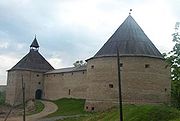
The territory of present-day Leningrad Oblast was populated shortly after the end of the Weichsel glaciation and hosts numerous archaeological remnants.[12][13][14] The Volga trade route and trade route from the Varangians to the Greeks crossed the territory. Staraya Ladoga, the first capital of legendary Rurik, founded in the 8th-9th century, is situated in the east of the oblast, on the River Volkhov.
In the 12th-15th century the territory was divided between the Kingdom of Sweden and Novgorod Republic (see Swedish-Novgorodian Wars) and mostly populated by Karelians (northwest), Izhorians and Votes (west), Veps (east) and Novgorodian East Slavs (south). During the Russo-Swedish Wars of the 15th-17th centuries the border moved back and forth over the land.
The central part of the territory is known as the historical region of Ingria and in the 17th century, after most of the present-day territory of Leningrad Oblast was captured by Sweden with the Treaty of Stolbovo of 1617, became subject to substantial Finnish Lutheran population influx from Finnish Karelia (which included Karelian Isthmus, the northwestern part of present-day Leningrad Oblast) and Savonia. Ingrian Finns soon became the dominant ethnic group.
During the Great Northern War (1700–1721) the territory of Leningrad Oblast was returned from Sweden by Russia under Peter I, who founded Saint Petersburg amidst the land in 1703, which soon became the capital of the Russian Empire. In 1708 most of the territory was organized into the Ingermanland Governorate under Governor General Alexander Menshikov. It was renamed Saint Petersburg Governorate in 1710 (Borders of the governorate, however, differed very significantly from those of the present-day oblast). In 1721 the territorial concessions of Sweden were confirmed with the Treaty of Nystad.
The life of the countryside was greatly influenced by the vicinity of the imperial capital, which became a growing market for its agricultural production as well as the main consumer of its mineral and forest resources. In 1719-1810, Ladoga Canal was dug between the River Svir and the River Neva as part of the Volga-Baltic waterway to bypass stormy waters of Lake Ladoga. Since the advent of the rail transport in the late 19th century, the vicinity of Saint Petersburg has been a popular summer resort (dacha) place for its residents. However, while Saint Petersburg itself from the very beginning was populated mostly by Russians, it wasn't until the 20th century that its surroundings were russified.
In 1914 with the beginning of World War I the governorate was renamed Petrograd Governorate after its namesake city. After the Russian Revolution, in 1918 the capital was transferred from Petrograd (how Saint Petersburg came to be named in 1914) to Moscow, farther from the borders of the country. In 1919 during the Russian Civil War the Northwestern White Army advancing from Estonia and led by Nikolai Yudenich tried to capture Petrograd and even managed to reach its southern outskirts, but the attack against the Red Army under Leon Trotsky ultimately failed, and Yudenich retreated back. The border with Estonia was established in the Russian-Estonian Treaty of Tartu of 1920. Ingrian Finns of North Ingria attempted to secede in 1918-1920, but were incorporated back with the Russian-Finnish Treaty of Tartu, which settled the border between Finland and Soviet Russia. In 1924 Petrograd Governorate was renamed to Leningrad Governorate, again after its namesake city.
Leningrad Oblast
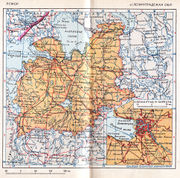
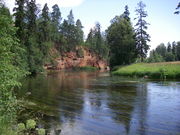
Leningrad Oblast was created in 1927 as a discontinuous merger of the Leningrad, Novgorod, Pskov, Cherepovets and Murmansk Governorates, corresponding to the territories of present-day Leningrad Oblast (except most of the Karelian Isthmus and territories along the border with Estonia), Saint Petersburg, Novgorod Oblast, Pskov Oblast, parts of Vologda Oblast and most of Murmansk Oblast forming an exclave in the north (total area of 360.4 thousand km², more than four times larger than the present-day oblast). In 1929 Velikoluksky District was transferred to newly formed Western Oblast. Leningrad was administratively separated from Leningrad Oblast in December 1931. In 1935 five southernmost districts were made part of Kalinin Oblast. In 1936 some parts of the territory of Leningrad Suburban District of Leningrad was returned back to Leningrad Oblast and divided into Vsevolozhsky District, Krasnoselsky District, Pargolovsky District and Slutsky District (renamed Pavlovsky District in 1944). Vologda Oblast, which has included the easternmost districts of Leningrad Oblast (former Cherepovets Governorate), was created in 1937. Murmansk Oblast was excluded from Leningrad Oblast in 1938.
In the fall of 1934 the Forbidden Border Zone along the western border of the Soviet Union was established, where nobody could appear without special permission issued by NKVD. It was officially only 7.5 km deep initially, but along the Estonian border it extended to as much as 90 km. The zone was to be free of Finnic and some other peoples, who were considered politically unreliable.[15][16] Starting from the 1935, the Soviet authorities caried out mass forced transfer of the Ingrian Finnish population of the oblast, which constituted majority in many rural localities as late as in the beginning of the centurty, to the east, replacing them with people from other parts of the Soviet Union.
On November 30, 1939, the Soviet Union waged the Winter War against neighboring Finland and with the Moscow Peace Treaty in 1940 gained some territories, including Karelian Isthmus. Their Karelian population was hastily evacuated to inner Finland and later replaced with people from other parts of the Soviet Union. A small part of the territory (the districts of Kanneljärvi, Koivisto and Rautu) was incorporated into Leningrad Oblast, the rest being included within the Karelo-Finnish SSR.
In 1941 Nazi Germany invaded the Soviet Union in the Operation Barbarossa, and shortly thereafter the territory became place of the Battle of Leningrad. Wehrmacht captured the southwestern part of the oblast and reached Tikhvin in the east, while Finnish troops quickly recaptured the ceded territories in the Continuation War, encircling Leningrad from the land. In 1944 Soviet offensives managed to expel Wehrmacht and put military pressure on Finland, which ceded Karelian Isthmus again with the Moscow Armistice of September 19, 1944. This time the gained territories of the isthmus was incorporated within Leningrad Oblast (Vyborgsky and Priozersky Districts). In 1947 the territorial gains were confirmed with the Paris Peace Treaty. Novgorod and Pskov Oblasts were formed out of the southern parts of Leningrad Oblast in 1944. In January 1945 a small part of the Estonian SSR to the east of the River Narva with the town of Jaanilinn (now Ivangorod) was transferred to the Russian SFSR and incorporated into Leningrad Oblast. Since then, the territory of Leningrad Oblast hasn't changed much, although some suburbs of Leningrad (now Saint Petersburg) have been excluded from the oblast and incorporated into the city.[17] In October 1946 Leningrad gained from the oblast some former Finnish territories along the northern coast of the Gulf of Finland divided into Sestroretsky District and Kurortny District, including the town of Terijoki.
In 1953 Pavlovsky District of the oblast was abolished, and parts of its territory including Pavlovsk were made subordinate to Leningrad. In 1954 the settlements Levashovo, Pargolovo and Pesochny were also transferred to Leningrad. In 1956 Boksitogorsky District of Leningrad Oblast gained a small territory of Novgorod Oblast. Uritsk was transferred from the oblast to the city of Leningrad in 1963, Krasnoye Selo and several settlements nearby—in 1973, Lomonosov -- in 1978.
Nature
Flora
The most taxonomically diverse vascular plant families are Asteraceae, Cyperaceae, Poaceae and Rosaceae. By far the most diverse genus is Carex (68 species). The diversity in genera Hieracium (with Pilosella), Ranunculus (with Batrachium), Alchemilla, Galium, Potamogeton, Salix, Veronica, Viola, Juncus, Artemisia, Potentilla, Rumex, Festuca, Epilobium, Poa, Trifolium, Campanula, Vicia, Lathyrus, Geranium is also considerable. The territory has no endemic plant taxa. Vascular plant species of Leningrad Oblast listed in the red data book of Russia are Botrychium simplex, Cephalanthera rubra, Cypripedium calceolus, Epipogium aphyllum, Lobelia dortmanna, Myrica gale, Ophrys insectifera, Orchis militaris, Pulsatilla pratensis, Pulsatilla vernalis. [1]
Administrative divisions
Demographics
Population: (2002) 1,669,205. For the first half of 2007, the birth rate was 8.1 per 1000 [2]
Ethnic groups: According to the (2002 Census) there were thirteen recognised ethnic groups of more than two thousand persons each; the 'national composition' was
- Russian 89.58%
- Ukrainian 2.51%
- Belarusians 1.70%
- Tatar 0.57%
- Finnish 0.48%
- Armenian 0.33%
- Roma 0.27
- Azeri 0.23%
- Chuvash 0.17%
- German 0.14%
- Mordvin 0.13%
- Karelian 0.12%
- Vep 0.12%
- Moldovan 0.12%
- Jewish 0.10%
- Polish 0.10%
- Georgian 0.09%
- Estonian 0.08%
- Bashkir 0.07%
- Korean 0.06%
- Uzbek 0.06%
- Mari 0.06%
- Udmurt 0.06%
- Tajik 0.05%
- Kazakh 0.05%
and many other ethnic groups of less than eight hundred persons each. A further 2.34% of residents declined to state their nationality on the census questionnaire.[18]
Twin regions
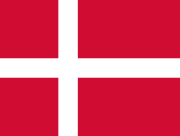 Aarhus Municipality, Denmark
Aarhus Municipality, Denmark Chungcheongnam-do, South Korea
Chungcheongnam-do, South Korea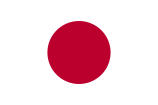 Kyoto Prefecture, Japan
Kyoto Prefecture, Japan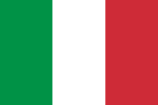 Lombardy, Italy
Lombardy, Italy Lower Silesian Voivodeship, Poland
Lower Silesian Voivodeship, Poland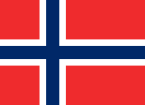 Nordland, Norway from 1987
Nordland, Norway from 1987
See also
- Ingria
- Saint Petersburg Governorate
References
- ↑ Президент Российской Федерации. Указ №849 от 13 мая 2000 г. «О полномочном представителе Президента Российской Федерации в федеральном округе». Вступил в силу 13 мая 2000 г. Опубликован: "Собрание законодательства РФ", №20, ст. 2112, 15 мая 2000 г. (President of the Russian Federation. Decree #849 of May 13, 2000 On the Plenipotentiary Representative of the President of the Russian Federation in a Federal District. Effective as of May 13, 2000).
- ↑ Госстандарт Российской Федерации. №ОК 024-95 27 декабря 1995 г. «Общероссийский классификатор экономических регионов. 2. Экономические районы», в ред. Изменения №5/2001 ОКЭР. (Gosstandart of the Russian Federation. #OK 024-95 December 27, 1995 Russian Classification of Economic Regions. 2. Economic Regions, as amended by the Amendment #5/2001 OKER. ).
- ↑ According to Article 13 of the Charter of Leningrad Oblast, the government bodies of the oblast are located in the city of St. Petersburg. However, St. Petersburg is not officially named to be the administrative center of the oblast.
- ↑ According to Article 68.1 of the Constitution of Russia, Russian is the official language on the whole territory of the Russian Federation. Article 68.2 further stipulates that only the republics have the right to establish official languages other than Russian.
- ↑ 5.0 5.1 5.2 Федеральная служба государственной статистики (Federal State Statistics Service) (2004-05-21). "Численность населения России, субъектов Российской Федерации в составе федеральных округов, районов, городских поселений, сельских населённых пунктов – районных центров и сельских населённых пунктов с населением 3 тысячи и более человек (Population of Russia, its federal districts, federal subjects, districts, urban localities, rural localities—administrative centers, and rural localities with population of over 3,000)" (in Russian). Всероссийская перепись населения 2002 года (All-Russia Population Census of 2002). Federal State Statistics Service. http://perepis2002.ru/ct/html/TOM_01_04_1.htm. Retrieved 2010-03-01.
- ↑ The value of density was calculated automatically by dividing the 2002 Census population by the area specified in the infobox. Please note that this value may not be accurate as the area specified in the infobox is not necessarily reported for the same year as the Census (2002).
- ↑ Федеральная служба государственной статистики (Federal State Statistics Service) (2004-05-21). "Территория, число районов, населённых пунктов и сельских администраций по субъектам Российской Федерации (Territory, Number of Districts, Inhabited Localities, and Rural Administration by Federal Subjects of the Russian Federation)" (in Russian). Всероссийская перепись населения 2002 года (All-Russia Population Census of 2002). Federal State Statistics Service. http://perepis2002.ru/ct/html/TOM_01_03.htm. Retrieved 2008-10-17.
- ↑ Charter, Article 18.1
- ↑ Official website of Leningrad Oblast. Valery Pavlovich Serdyukov, Governor of Leningrad Oblast (Russian)
- ↑ Charter, Article 25.1
- ↑ A previous name of Saint Petersburg in 1924–1991 in honor of Vladimir Lenin. Leningrad Oblast retained its name in 1991 after a referendum, while its namesake city was renamed back to Saint Petersburg.
- ↑ Лапшин В. А. Археологическая карта Ленинградской области. Часть 1: Западные районы. Leningrad, 1990.
- ↑ Лапшин В. А. Археологическая карта Ленинградской области. Часть 2: Восточные и северные районы. Saint Petersburg: Изд. СПбГУ, 1995. ISBN 5874030522.
- ↑ Лебедев Г. С. Археологические памятники Ленинградской области. Leningrad: Лениздат, 1977.
- ↑ Matley, Ian M. (1979). The Dispersal of the Ingrian Finns. Slavic Review 38.1, 1-16.
- ↑ Martin, Terry (1998). The Origins of Soviet Ethnic Cleansing. The Journal of Modern History 70.4, 813-861.
- ↑ Ленинградская область в целом: Административно-территориальное деление Ленинградской области
- ↑ (XLS) National Composition of Population for Regions of the Russian Federation. 2002 Russian All-Population Census. 2002. http://www.perepis2002.ru/ct/doc/English/4-2.xls. Retrieved 2006-07-20.
Sources
- Закон №6-оз от 27 октября 1994 г. «Устав Ленинградской области», в ред. Закона №51-оз от 5 июня 2009 г. «О внесении изменения в областной закон "Устав Ленинградской области"». Вступил в силу со дня официального публикования. Опубликован: "Вестник Правительства Ленинградской области", №1, 12 января 1995 г. (Law #6-oz of October 27, 1994 Charter of Leningrad Oblast, as amended by the Law #51-oz of June 5, 2009 On Amending the Oblast Law "Charter of Leningrad Oblast". Effective as of the official publication date).
Further reading
Nature
- Айрапетьянц А.Э., Стрелков П.П., Фокин И.М. Звери. [Природа Ленинградской области]. Leningrad: Лениздат, 1987.
- Балашова Н.Б., Никитина В.Н. Водоросли [Природа Ленинградской области]. Leningrad: Лениздат, 1989. ISBN 5289003444
- Биоразнообразие Ленинградской области (Водоросли. Грибы. Лишайники. Мохообразные. Беспозвоночные животные. Рыбы и рыбообразные) / Под. ред. Н.Б.Балашовой, А.А.Заварзина. - (Труды Санкт-Петербургского общества естествоиспытателей. Серия 6. Том 2.). – Saint Petersburg: Изд-во СПб. университета, 1999.
- Бобров Р.В. Леса Ленинградской области. Leningrad: Лениздат, 1979.
- Бродский А.К., Львовский А.Л. Пауки, насекомые [Природа Ленинградской области]. Leningrad: Лениздат, 1990. ISBN 528900610X
- Иллюстрированный определитель растений Ленинградской области / Под ред. А. Л. Буданцева, Г. П. Яковлева. Moscow: КМК, 2006. ISBN 5873172609
- Кириллова М.А., Распопов И.М. Озера Ленинградской области. Leningrad: Лениздат, 1971.
- Красная Книга природы Ленинградской области. Том 1. Особо охраняемые природные территории. Отв. ред. Г.А. Носков, М. С. Боч [Red Data Book of Nature of the Leningrad Region. Vol. 1. Protected Areas]. Saint Petersburg: Акционер и К, 1998. ISBN 5874010726
- Красная Книга природы Ленинградской области. Том 2. Растения и грибы. Отв. ред. Г.А. Носков [Red Data Book of Nature of the Leningrad Region. Vol. 2. Plants and Fungi]. Saint Petersburg: Мир и Семья, 2000. ISBN 5943650016
- Красная Книга природы Ленинградской области. Том 3. Животные. Отв. ред. Г.А. Носков [Red Data Book of Nature of the Leningrad Region. Vol. 3. Animals]. Saint Petersburg: Мир и Семья, 2002. ISBN 5943650210
- Леса Ленинградской области: современное состояние и пути их возможного развития. Saint Petersburg, 1998. ISBN 5230104570
- Мальчевский А. С., Пукинский Ю. Б. Птицы Ленинградской области и сопредельных территорий. История, биология, охрана. Т.1-2. Leningrad: Изд-во ЛГУ, 1983.
- Наумов Н.А. Флора грибов Ленинградской области. Том 1. Архимицеты и фикомицеты [The Fungus Flora of the Leningrad Region. Vol. 1. Archimycetes, Phycomycetes]. Moscow – Leningrad: Изд-во АН СССР, 1954.
- Наумов Н.А. Флора грибов Ленинградской области. Том 2 [The Fungus Flora of the Leningrad Region. Vol. 2]. Moscow – Leningrad: Наука, 1964.
- Неелов, А.В. Рыбы [Природа Ленинградской области]. Leningrad: Лениздат, 1987.
- Покровская Г.В., Бычкова А.Т. Климат Ленинграда и его окрестностей. Leningrad: Гидрометеоиздат, 1967.
- Природа Ленинградской области и ее охрана / Ред. Т.И. Миронова, Э.И. Слепян. - Leningrad: Лениздат, 1983.
- Пукинский Ю. Б. Птицы [Природа Ленинградской области]. Leningrad: Лениздат, 1988.
- Свидерская М.Д., Храбрый В.М. Сохраним для потомков: Особо охраняемые природные территории Ленинградской области. Leningrad: Лениздат, 1985.
- Старобогатов Я.И. Раки, моллюски [Природа Ленинградской области]. Leningrad: Лениздат, 1988. ISBN 5289001255
- Филимонов Р.В., Удалов С.Г. Жуки-усачи Ленинградской области. Атлас-определитель. [Longhorn Beetles of the St. Petersburg Region: An Identification Atlas]. Saint Petersburg: Петроглиф, 2001. ISBN 5902094054
- Флора Ленинградской области / Под ред. Б. К. Шишкина. Вып. 1-4. Leningrad: Изд. ЛГУ, 1955-1965.
- Хазанович К. К. Геологические памятники Ленинградской области. Leningrad: Лениздат, 1982.
- Черепанова Н.П., Пшедецкая Л.И. Грибы. [Природа Ленинградской области]. Leningrad: Лениздат, 1990.
History
- Лапшин В. А. Археологическая карта Ленинградской области. Часть 1: Западные районы. Leningrad, 1990.
- Лапшин В. А. Археологическая карта Ленинградской области. Часть 2: Восточные и северные районы. Saint Petersburg: Изд. СПбГУ, 1995. ISBN 5874030522
- Лебедев Г. С. Археологические памятники Ленинградской области. Leningrad: Лениздат, 1977.
External links
- (English) Official website of Leningrad Oblast
- (Russian) Official website of Leningrad Oblast
- (English) Map of Leningrad Oblast
- (Russian) Weather records for Leningrad Oblast
- (Russian) Detailed and historical maps
- (English) Leningrad oblast nature views
|
||||||||||||||